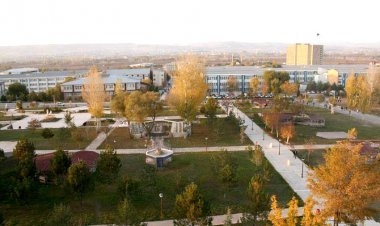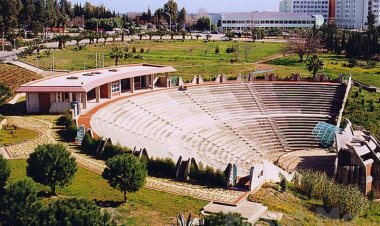Baraj İnşaatlarında İş Sağlığı Güvenliği ve Risk Değerlendirmesi
Baraj İnşaatlarında İş Sağlığı Güvenliği ve Risk Değerlendirmesi Şakar, Yılmaz Çalışma, Erdemli İlçesinde inşaat aşamasında olan Sorgun Barajında baraj yeri ve göl alanının mühendislik jeolojisi yönünden yapılabilirliğini araştırmak, duraylılık ve geçirimlilik sorunlarını belirlemek, baraj inşası sırasında teknik yönden ve personel kaynaklı olabilecek hataların iş kazalarına yol açmaması için iyileştirici önerileri sunmak amacıyla yapılmıştır. Risk değerlendirmesinde kullanılan veriler kayıt altına alınırken; sahadaki çalışma esnasında personellerin iş pozisyonundaki davranışları, iş makinalarının topoğrafyadaki durumu, kazı şev stabilitesi gözlemlenmiştir. Risk değerlendirmesinde olası tehlikelerin ortadan kaldırılması veya azaltılması için planlanan önerilerin geliştirilmesinde saha incelemesinden, ilgili kanun ve yönetmeliklerden faydalanılmıştır. Risk analiz metodolojileri incelenerek değerlendirmenin hazırlık aşamasında Tehlike ve İşletebilirlik Analiz Yöntemi (HAZOP) , Olursa Ne Olur (What İf….? ) ve Birincil Risk Analizi (PRA) metotlarından faydalanılmış, değerlendirme yöntemi olarak L Tipi Matris (5 x 5) belirlenmiştir. L Tipi Matris Yönteminin belirlenmesinde bu metodun OHSAH 180001 ‘ in temelini oluşturan BS 8800 standardında konu olması, uygulanan proseste yeniden tasarlanabilmesi ve yapılandırılabilmesi, anlaşılır sadelikte olması, bir analist tarafından gerçekleştirilmesi, hata-tehlike-eksiklerin derecelendirilip meydana gelebilecek olumsuzlukların kaynağında yok edilmesi veya azaltılması için öneriler geliştirmesi gibi nedenler mesnet olmuştur. Yapılan risk analizi ile iş sağlığı ve güvenliği yönünden iş kazalarının tespiti, azaltılması ve emniyetli bir baraj inşası için yapılması gereken esaslar belirlenmeye çalışılmıştır.; The study was carried out to investigate the feasibility of the dam site and lake area in terms of engineering geology in Sorgun Dam, which is under construction in Erdemli District, to determine the stability and permeability problems, and to offer remedial suggestions so that technical and personnel-related errors during the construction of the dam do not lead to occupational accidents. Alongside with the risk assessments, the following was also considered during the work in the field; the behaviour of the personnel in the work position, the topography of the construction equipment, the stability of the excavation slope were observed. Field investigation, relevant laws and regulations were used in the development of the proposals planned to eliminate or reduce possible hazards in risk assessment. During the examination of risk analysis methodologies, the following methods were used in the preparation phase; Hazard and Operability Analysis Method (HAZOP), What If (What If?) and Primary Risk Analysis (PRA). L Type Matrix (5 x 5) was determined as the evaluating method. In determining the L-Type Matrix Method the following reasons has supported the development and conclusion. These include that the L-Type Matrix method is subject to the BS 8800 standard; which forms the basis of OHSAH 180001; it can be redesigned and reconfigured in the application process; it is in a simple and understandable format; it can be carried out by an analyst; the error-hazard-deficiencies can be graded and the problems that may occur are eliminated or reduced at the source. With the risk analysis made, an attempt has been made to determine the principles that should be done for the detection and reduction of occupational accidents in terms of occupational health and safety and the construction of a safe dam.

Baraj İnşaatlarında İş Sağlığı Güvenliği ve Risk Değerlendirmesi Şakar, Yılmaz Çalışma, Erdemli İlçesinde inşaat aşamasında olan Sorgun Barajında baraj yeri ve göl alanının mühendislik jeolojisi yönünden yapılabilirliğini araştırmak, duraylılık ve geçirimlilik sorunlarını belirlemek, baraj inşası sırasında teknik yönden ve personel kaynaklı olabilecek hataların iş kazalarına yol açmaması için iyileştirici önerileri sunmak amacıyla yapılmıştır.
Risk değerlendirmesinde kullanılan veriler kayıt altına alınırken; sahadaki çalışma esnasında personellerin iş pozisyonundaki davranışları, iş makinalarının topoğrafyadaki durumu, kazı şev stabilitesi gözlemlenmiştir. Risk değerlendirmesinde olası tehlikelerin ortadan kaldırılması veya azaltılması için planlanan önerilerin geliştirilmesinde saha incelemesinden, ilgili kanun ve yönetmeliklerden faydalanılmıştır.
Risk analiz metodolojileri incelenerek değerlendirmenin hazırlık aşamasında Tehlike ve İşletebilirlik Analiz Yöntemi (HAZOP) , Olursa Ne Olur (What İf….? ) ve Birincil Risk Analizi (PRA) metotlarından faydalanılmış, değerlendirme yöntemi olarak L Tipi Matris (5 x 5) belirlenmiştir. L Tipi Matris Yönteminin belirlenmesinde bu metodun OHSAH 180001 ‘ in temelini oluşturan BS 8800 standardında konu olması, uygulanan proseste yeniden tasarlanabilmesi ve yapılandırılabilmesi, anlaşılır sadelikte olması, bir analist tarafından gerçekleştirilmesi, hata-tehlike-eksiklerin derecelendirilip meydana gelebilecek olumsuzlukların kaynağında yok edilmesi veya azaltılması için öneriler geliştirmesi gibi nedenler mesnet olmuştur.
Yapılan risk analizi ile iş sağlığı ve güvenliği yönünden iş kazalarının tespiti, azaltılması ve emniyetli bir baraj inşası için yapılması gereken esaslar belirlenmeye çalışılmıştır.;
The study was carried out to investigate the feasibility of the dam site and lake area in terms of engineering geology in Sorgun Dam, which is under construction in Erdemli District, to determine the stability and permeability problems, and to offer remedial suggestions so that technical and personnel-related errors during the construction of the dam do not lead to occupational accidents. Alongside with the risk assessments, the following was also considered during the work in the field; the behaviour of the personnel in the work position, the topography of the construction equipment, the stability of the excavation slope were observed. Field investigation, relevant laws and regulations were used in the development of the proposals planned to eliminate or reduce possible hazards in risk assessment. During the examination of risk analysis methodologies, the following methods were used in the preparation phase; Hazard and Operability Analysis Method (HAZOP), What If (What If?) and Primary Risk Analysis (PRA). L Type Matrix (5 x 5) was determined as the evaluating method. In determining the L-Type Matrix Method the following reasons has supported the development and conclusion. These include that the L-Type Matrix method is subject to the BS 8800 standard; which forms the basis of OHSAH 180001; it can be redesigned and reconfigured in the application process; it is in a simple and understandable format; it can be carried out by an analyst; the error-hazard-deficiencies can be graded and the problems that may occur are eliminated or reduced at the source. With the risk analysis made, an attempt has been made to determine the principles that should be done for the detection and reduction of occupational accidents in terms of occupational health and safety and the construction of a safe dam.

 Bilgi
Bilgi 














